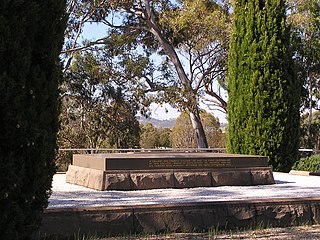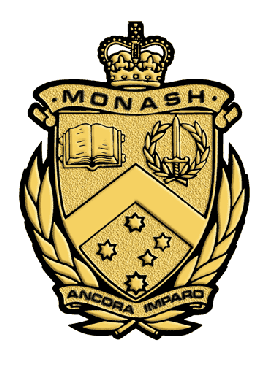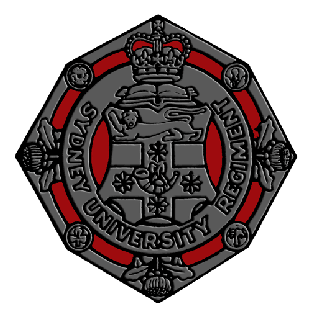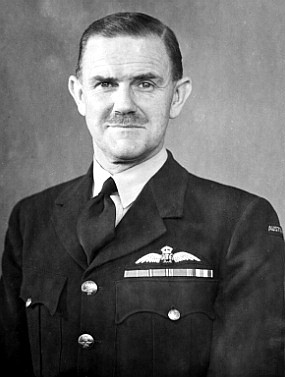
Major General Sir William Throsby Bridges, was a senior Australian Army officer who was instrumental in establishing the Royal Military College, Duntroon and who served as the first Australian Chief of the General Staff. During the First World War he commanded the 1st Australian Division at Gallipoli, where he died of wounds on 18 May 1915, becoming the first Australian general officer to be killed during the war. He was the first Australian officer—and the first graduate of Kingston—to reach the rank of major general, the first to command a division, and the first to receive a knighthood. He is one of only two Australians killed in action in the Great War to be interred in Australia.

The Royal Military College, Duntroon, also known simply as Duntroon, is the Australian Army's officer training establishment. It was founded at Duntroon, in Canberra, Australian Capital Territory, in 1911 and is at the foot of Mount Pleasant near Lake Burley Griffin, close to the Department of Defence headquarters at Russell Hill. It is comparable to the United Kingdom's Royal Military Academy Sandhurst and the United States Military Academy at West Point. Duntroon is adjacent to the Australian Defence Force Academy (ADFA), which is Australian Defence Force's tri-service military academy that provides military and tertiary academic education for junior officers of the Australian Army, Royal Australian Air Force and the Royal Australian Navy.

The Officer Cadet School, Portsea was an officer training establishment of the Australian Army. Established at Portsea in Victoria, Australia, in 1951 to provide training to officer cadets prior to commissioning, for many years OCS provided the Australian Regular Army with the bulk of its junior officers. However, following a review of military training establishments in Australia in the mid-1980s, the school was eventually closed in 1985, as the Royal Military College, Duntroon, assumed sole responsibility for training Army officers.
Major General Elizabeth Cosson, served as Secretary of the Department of Veterans' Affairs from 2018-2023. Cosson "vowed" to resign as Secretary of the Department of Veterans’ Affairs, on 19 July 2020, if she cannot improve the department’s relationship with veterans stating in a media interview on 19 July 2019 that "if I’m still part of the problem in 12 months I will hand over [the job]."

The Australian Defence Force Academy (ADFA) is a tri-service military Academy that provides military and academic education for junior officers of the Australian Defence Force in the Royal Australian Navy (RAN), Australian Army and Royal Australian Air Force (RAAF). In 2016 the Academy began accepting civilian students in its undergraduate courses.

The Monash University Regiment was an officer training regiment of the Australian Army, based in Victoria near Monash University. It was a direct command training unit of the 4th Brigade, and part of the 2nd Division, it was responsible for training of ARes officer cadets (OCDTs) for graduation as lieutenants, and provided driver training and promotion courses for junior non commissioned officers.

Sydney University Regiment (SUR) is an officer-training regiment of the Australian Army Reserve. Its predecessor, the University Volunteer Rifle Corps, was raised in 1900 as a unit of the colonial New South Wales Defence Force. During the 20th century, several changes of name and role occurred. Sydney University Regiment is headquartered in Holsworthy Barracks and has detachments in Sydney, Canberra and Wollongong.

Air Vice-Marshal William Hopton Anderson, was a senior commander in the Royal Australian Air Force (RAAF). He flew with the Australian Flying Corps in World War I, earning the Distinguished Flying Cross and the Belgian Croix de guerre for his combat service with No. 3 Squadron on the Western Front in 1917. The following year he took command of No. 7 (Training) Squadron and, later, No. 3 Squadron. Anderson led the Australian Air Corps during its brief existence in 1920–21, before joining the fledgling RAAF. The service's third most-senior officer, he primarily held posts on the Australian Air Board in the inter-war years. He was appointed a Commander of the Order of the British Empire in 1934, and promoted to air commodore in 1938.

Air Marshal Sir Valston Eldridge Hancock, was a senior commander in the Royal Australian Air Force (RAAF). He served as Chief of the Air Staff from 1961 to 1965. A graduate of the Royal Military College, Duntroon, Hancock transferred from the Army to the RAAF in 1929 and qualified as a pilot. His administrative training at Duntroon saw him mainly occupy staff posts, including Deputy Director of Operations and Intelligence at RAAF Headquarters from 1931 to 1935, and Director of Works and Buildings from 1937 to 1939. During the early years of World War II, he commanded No. 1 Bombing and Gunnery School, and held senior planning and administrative positions. He eventually saw combat in the Aitape–Wewak campaign of the Pacific War during 1945. Flying Bristol Beaufort light bombers, he led first No. 100 Squadron, and later No. 71 Wing. His actions earned him the Distinguished Flying Cross.

General Sir John Gordon Noel Wilton, was a senior commander in the Australian Army. He served as Chief of the General Staff (CGS), the Army's professional head, from 1963 until 1966, and as Chairman of the Chiefs of Staff Committee (CCOSC), forerunner of the role of Australia's Chief of the Defence Force, from 1966 until 1970. His eight-year tenure as senior officer of first the Army and then the Australian military spanned almost the entire period of the nation's involvement in the Vietnam War.

Air Marshal Sir Alister Murray Murdoch, was a senior commander in the Royal Australian Air Force (RAAF). He served as Chief of the Air Staff (CAS) from 1965 to 1969. Joining the Air Force in 1930, Murdoch trained as a seaplane pilot and participated in an Antarctic rescue mission for lost explorers in 1935. During World War II, he commanded No. 221 Squadron RAF in Europe and the Middle East, and later occupied senior positions on the staff of RAAF formations in the South West Pacific. His post-war appointments included Commandant of RAAF College from 1952 to 1953, Air Officer Commanding (AOC) Training Command from 1953 to 1955, Deputy Chief of the Air Staff from 1958 to 1959, and AOC Operational Command from 1962 to 1965.

Air Vice-Marshal Francis Masson Bladin, was a senior commander in the Royal Australian Air Force (RAAF). Born in rural Victoria, he graduated from the Royal Military College, Duntroon, in 1920. Bladin transferred from the Army to the Air Force in 1923, and learned to fly at RAAF Point Cook, Victoria. He held training appointments before taking command of No. 1 Squadron in 1934. Quiet but authoritative, he was nicknamed "Dad" in tribute to the concern he displayed for the welfare of his personnel.

Major General Ronald Nicholas Lamond Hopkins CBE was a senior officer in the Australian Army. He began his military career in 1915 when he entered the Royal Military College, Duntroon as a staff cadet and graduated as a lieutenant in the Permanent Forces in late 1917. Following this, he was deployed overseas and subsequently served in the Sinai and Palestine Campaign during the First World War. During the inter war years, Hopkins undertook a variety of regimental and staff positions in Australia, India and the United Kingdom. During the Second World War, he was promoted several times, briefly commanding the 7th Division Cavalry Regiment and was deployed to the Middle East before returning to Australia to undertook further staff positions. In this role he played a key role in organising the Australian Armoured Corps before later serving as a liaison officer to American forces taking part in the New Guinea campaign. Following the war, Hopkins commanded the 34th Brigade in Japan, before finishing his career as Commandant of the Royal Military College, Duntroon. In retirement he wrote a comprehensive history of the Royal Australian Armoured Corps before he died in 1990 at the age of 93.

Air Vice Marshal William Lloyd Hely, CB, CBE, AFC was a senior commander in the Royal Australian Air Force (RAAF). He graduated from the Royal Military College, Duntroon, in 1930 before transferring to the RAAF as a cadet pilot. Hely came to public attention in 1936–37, first when he crashed on a survey flight in the Northern Territory, and later when he undertook two successful missions to locate missing aircraft in the same vicinity. His rescue efforts earned him the Air Force Cross. After occupying staff positions during the early years of World War II, Hely was appointed Officer Commanding No. 72 Wing in Dutch New Guinea in May 1944. Later that year he formed No. 84 Wing, commanding it during the Bougainville campaign until the end of the Pacific War.

Major General Simone Louise Wilkie, is a retired Australian Army officer who was the Australian Deputy National Commander in the War in Afghanistan in 2011 and 2012. She was Assistant Chief of Staff to General David Petraeus during the Iraq War troop surge of 2007, and was the first female Commanding Officer of the Royal Military College, Duntroon and Commandant at the Army Recruit Training Centre at Kapooka. In March 2013 the Minister for Defence, Stephen Smith, announced her promotion to major general to take over as Commander of the Australian Defence College in July 2013.
Major General Kathryn Leslei Toohey, is a retired senior officer of the Australian Army. She served as Head of Land Capability from 2017 to 2019, and Head Force Integration Division within the Vice Chief of the Defence Force Group from June 2019 to January 2023.
The Band of the Royal Military College is a band of the Australian Army that is located in Canberra, Australian Capital Territory. It is one of 11 bands that make up the Australian Army Band Corps. Also known as the Duntroon Military Band or the RMC Band, it is the chief musical ensemble of the Royal Military College, Duntroon. It is regarded as one of the premier bands in the AABC today. Since January 1993, the band has been under the direction of Ian McLean, who was himself part of the band in the 1970s.
Major General Jeffery John Sengelman, is a retired senior officer of the Australian Army. He joined the army via the Officer Cadet School, Portsea in 1980, was commissioned into the Royal Australian Infantry Corps and spent much of his military career in special forces. He commanded the 4th Battalion, Royal Australian Regiment (Commando) (2000–01) and the 6th Brigade (2010–11), deployed on operations to East Timor and Iraq, and served as Commander Forces Command in 2011, Deputy Chief of Army from 2011 to 2012, Head of Modernisation and Strategic Planning – Army from 2012 to 2014, and Special Operations Commander Australia from 2014 until his retirement in 2017.

Major General Justin Frederick Ellwood,, commonly known as Jake Ellwood, is a retired senior officer of the Australian Army. He joined the army via the Royal Military College, Duntroon in 1989 and was commissioned into the Royal Australian Infantry Corps. He commanded the 5th Battalion, Royal Australian Regiment (2006–08), Overwatch Battle Group (West) (2007), Battle Group Tiger (2008) and the Combat Training Centre, and deployed on operations to Kosovo, East Timor, Iraq and Afghanistan. He served as Deputy Chief of Army from May to December 2018, and commanded the 1st Division from December 2018 to November 2021.

Major General Susan May Coyle, is a senior officer in the Australian Army. She joined the army as a reservist in 1987 and, following training at the Australian Defence Force Academy, was commissioned into the Royal Australian Corps of Signals in 1992. She has commanded the 104th Signal Squadron (2003–04), 17th Signal Regiment (2009–10), Task Group Afghanistan (2015) and the 6th Combat Support Brigade (2017–19), and has deployed on operations to East Timor, the Solomon Islands and Afghanistan. She was appointed Commander Joint Task Force 633, with responsibility for all Australian operations in the Middle East, from January to November 2020. She was the first woman to command the task force, which had oversight for 1,200 personnel under Operation Accordion. Coyle was Head Information Warfare from January 2021 to November 2022, when she was appointed Commander Forces Command.
















